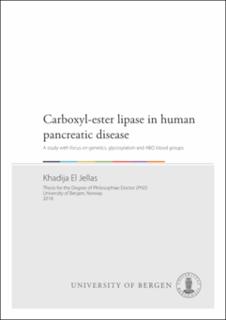| dc.contributor.author | El Jellas, Khadija | en_US |
| dc.date.accessioned | 2019-02-21T13:31:13Z | |
| dc.date.available | 2019-02-21T13:31:13Z | |
| dc.date.issued | 2018-09-28 | |
| dc.identifier.isbn | 978-82-308-3673-6 | en_US |
| dc.identifier.uri | https://hdl.handle.net/1956/19133 | |
| dc.description.abstract | Glycosylation is a post-translational modification where carbohydrates are attached to a protein or other organic molecule. Defects in glycosylation are seen in many human pathologies and may even be the underlying cause of some disorders. Here we have studied CEL and ABO, two genes that play a role in exocrine pancreatic disease, in particular as risk factors for chronic pancreatitis and pancreatic cancer. CEL encodes carboxyl-ester lipase, a glycosylated digestive enzyme secreted by the pancreas. The last exon of CEL contains a variable number of tandem repeats (VNTR) region, a highly polymorphic sequence translated into a protein C-terminal tail that undergoes mucin-type glycosylation. The ABO gene gives rise to a glycosyltransferase that synthesizes the A and B antigens of the ABO blood group system. We first examined whether genetic variants of CEL influenced the risk for the most common and serious type of pancreatic cancer, namely pancreatic ductal adenocarcinoma (PDAC). No association, neither for VNTR length nor for copy number variants (CNVs), was observed. Next, we tested the influence of ABO blood group on the risk for PDAC. Blood group O seemed to have a protective effect as individuals with this blood group were under-represented among cases compared with controls and also exhibited better survival when the tumour was unresectable. We then investigated the expression of CEL in PDAC resection specimens and pancreatic cell lines. CEL could not be detected in the neoplastic cells, neither at the mRNA nor at the protein level. When serine-/threonine-linked glycans were released from the mucinous domain of CEL and analysed by high-sensitivity mass spectrometry, we detected core 1- and core 2-based ABH antigen-containing structures in coherence with the genetically determined ABO blood type and FUT2 secretor status of each analyzed individual. The finding of ABH antigens on CEL raises interesting questions of additional biological roles of carboxylester lipase, for example in the gastrointestinal mucosal barrier. Finally, we performed glycan profiling of the disease-associated CEL variants CEL-MODY and CEL-HYB as well as the normal CEL protein after expression in HEK293 cells. Altered O- and N-linked glycan patters were seen in, respectively, the VNTR and the globular domain of the pathogenic CEL protein variants. In conclusion, although CEL VNTR length does not appear to influence susceptibility to exocrine pancreatic disease, aberrant glycosylation of CEL could be involved in pathological processes of the pancreas. | en_US |
| dc.language.iso | eng | eng |
| dc.publisher | The University of Bergen | eng |
| dc.relation.haspart | Paper I: Monica Dalva, Khadija El Jellas, Solrun J. Steine, Bente B. Johansson, Monika Ringdal, Janniche Torsvik, Heike Immervoll, Dag Hoem, Felix Laemmerhirt, Peter Simon, Markus M. Lerch, Stefan Johansson, Pål R.Njølstad, Frank U. Weiss, Karianne Fjeld and Anders Molven. Copy number variants and VNTR length polymorphisms of the carboxyl-ester lipase (CEL) gene as risk factors in pancreatic cancer. Pancreatology 2017; 17: 83-88. The article is available in the main thesis. The article is also available at: <a href="http://dx.doi.org/10.1016/j.pan.2016.10.006" target="blank">http://dx.doi.org/10.1016/j.pan.2016.10.006</a> | en_US |
| dc.relation.haspart | Paper II: Khadija El Jellas, Dag Hoem, Kristin G. Hagen, May Britt Kalvenes, Sura Aziz, Solrun J. Steine, Heike Immervoll, Stefan Johansson and Anders Molven. Associations between ABO blood groups and pancreatic ductal adenocarcinoma: influence on resection status and survival. Cancer Medicine 2017; 6: 1531-1540. The article is available at: <a href="http://hdl.handle.net/1956/18389" target="blank"> http://hdl.handle.net/1956/18389</a> | en_US |
| dc.relation.haspart | Paper III: Khadija El Jellas, Bente B. Johansson, Karianne Fjeld, Heike Immervoll, Man Hung Choi, Dag Hoem, Mark E. Lowe, Dominique Lombardo, Pål R. Njølstad, Anne Dell, Eric Mas, Stuart M. Haslam and Anders Molven. The mucinous domain of pancreatic carboxyl-ester lipase (CEL) contains core 1/core 2 O-glycans that can be modified by ABO blood group determinants. Journal of Biological Chemistry 2018; 293(50): 19476-19491. The article is available at: <a href="http://hdl.handle.net/1956/19132" target="blank"> http://hdl.handle.net/1956/19132</a> | en_US |
| dc.relation.haspart | Paper IV: Khadija El Jellas, Stuart M. Haslam, Man Hung Choi, Anne Dell, Pål R. Njølstad, Bente B. Johansson, Karianne Fjeld and Anders Molven. Altered O- and N-linked glycan profiles in carboxyl ester lipase (CEL) protein variants involved in MODY8 syndrome and chronic pancreatitis. The article is not available in BORA. | en_US |
| dc.rights.uri | https://creativecommons.org/licenses/by-nc/4.0/ | eng |
| dc.title | Carboxyl-ester lipase in human pancreatic disease. A study with focus on genetics, glycosylation and ABO blood groups | en_US |
| dc.type | Doctoral thesis | |
| dc.rights.holder | Copyright the author | |
| dc.identifier.cristin | 1615155 | |

